These 3 Sask. regional parks are treasure troves of memories, history and natural splendor

CBC's virtual road trip series Land of Living Stories explores the hidden gems across Saskatchewan.
Summertime means camping. And many of us have certain parks we flock to with campers, tents and barbecues in tow.
Regional parks hold a special place in the hearts of many people — some have been going to the same regional parks for most, if not all, of their lives.
So pack up your picnic baskets and beach umbrellas. It's time to hop in the car and travel to three of Saskatchewan's most beloved regional parks.
Pine Cree Regional Park
Pine Cree Regional Park — 17 kilometres north of Eastend, in southwestern Saskatchewan — is a small but magically natural park in the Cypress Hills. It has 27 non-serviced sites, many of which are situated along the headwaters of Swift Current Creek.
What strikes guests first is how dense the park is with trees, said Don Lundberg, vice-chair of the Pine Cree Regional Park board.
"People from Vancouver Island to the Maritimes ... land in Regina and drive down here, and there's not a tree. There's hardly anything to be seen," Lundberg said.
"But then they drive to the top of the hill and start down into here, and they can't believe it. They can't believe how that exists, right in the middle of … southern Saskatchewan."
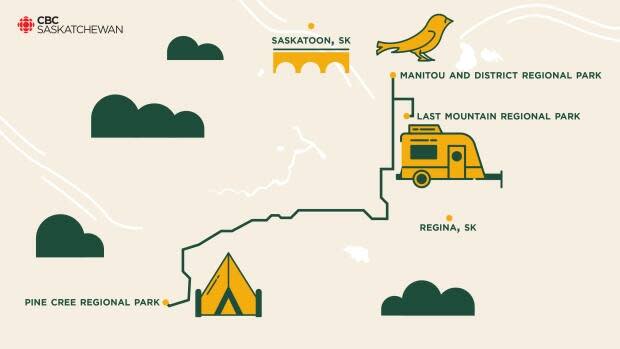
Lundberg has lived in the area all his life, and the park holds special memories for him. When he was a child, his school would go to Pine Cree for end of year field trips.
"Now today kids, heck, they'll go to Italy or go to England. My kids did. But we would come to Pine Cree. We were really excited. Like, that was a major event."
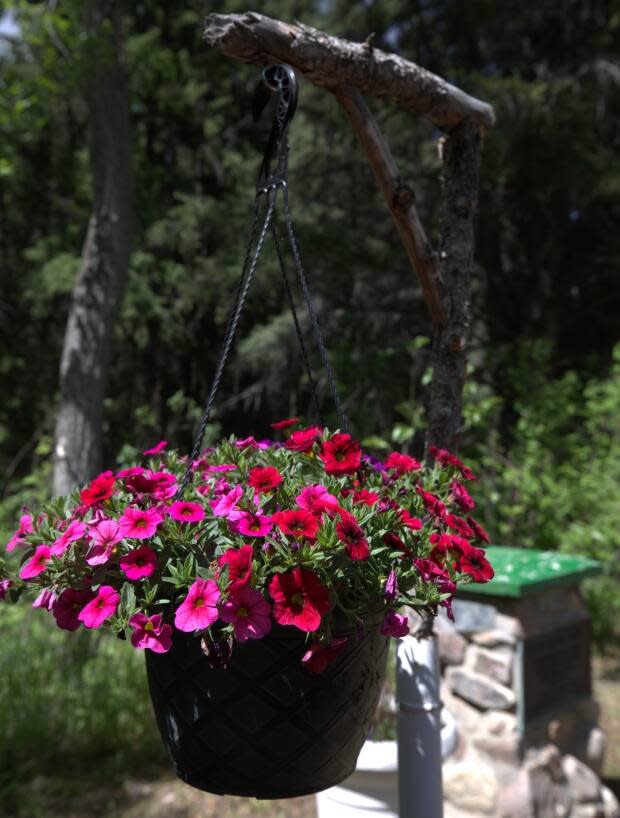
About 60 kids would swarm around the regional park during those trips, taking in all the trails and wildlife.
"We'd always come out in the bus in the morning and have a wiener roast in time to catch the buses in the afternoon to go home. And oh, we ran wild!"
Everett Baker's Pine Cree
Saskatchewan legend Everett Baker had a lot to do with the creation of Pine Cree Regional Park.
In 1917, Baker came up to southern Saskatchewan from his home state of Minnesota to sell books door to door, according to Hugh Henry, president of Saskatchewan History & Folklore Society.
After briefly returning to Minnesota to get married, Baker returned to Saskatchewan with his new bride to put down roots. In the following years, he would farm, become involved with the Saskatchewan Grain Growers' Association and the Saskatchewan Wheat Pool, and nurture a love of photography.
The Bakers moved to Shaunavon, about 30 kilometres east of Pine Cree, in 1948.
"He would have been involved early on with Pine Cree. A lot of people attribute it as his idea, and he did the initial groundwork for that," said Henry.
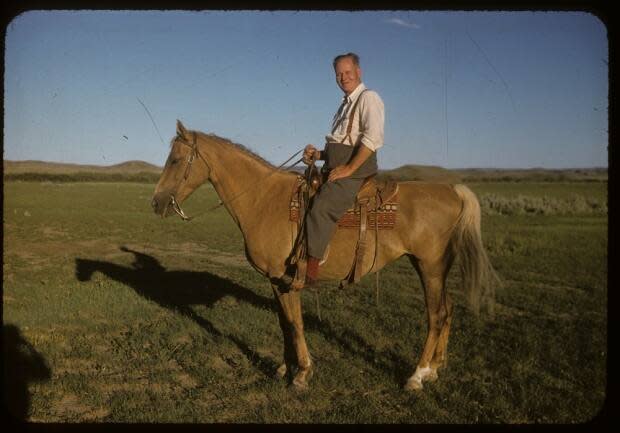
Baker began developing Pine Cree in the 1950s as a place where people could come to appreciate nature.
"That sort of stemmed from his interest in history, and particularly trying to make some connections with the Sitting Bull and the Lakota [and find out] where some of their camping spots may have been."
Henry said that through his talks with Indigenous people in the area, Baker learned that the area where Pine Cree Regional Park now sits would be an ideal spot for camping.
"That was a very special spot for him."
For a while, locals called the campground Baker's Coulee, but he didn't want that to continue.
"He didn't want any sort of personal notoriety for that and preferred, again, making a connection to Indigenous history there. And so it was his recommendation that it would be called Pine Cree," Henry said.
Hermit Cave
Pine Cree Regional Park has multiple trails that will take you through thick bushes and fields of wildflowers. And if you follow one of the trails into the far end of the campground, you'll stumble on a sign that reads "Hermit Cave."
At the end of a stack of wooden stairs is a tiny structure poking out of a hill. The legend of this "cave" dates back to the late 1960s.
"A geologist dug out a hole into the side of the hill up here, and he spent a winter here living in that hole in the ground," said Lundberg.
"People call him a hermit, but he's actually a recluse geologist."
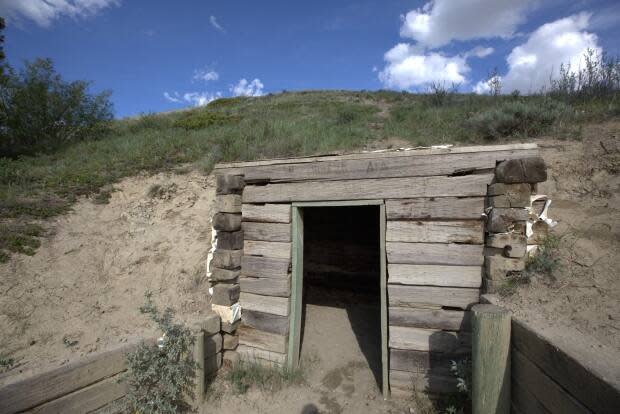
He recalls the man, whose name he cannot remember, walking into Eastend in the dead of winter for supplies. Lundberg and his father would sometimes give him a ride into town.
"He was just a different character. But the legend became more than the man, given time. He was really a different type of fellow."
The geologist spent approximately 10 months living in the side of the hill, and then one day simply left, never to return again. But locals will never forget him.
Last Mountain Regional Park
When you drive into Last Mountain Regional Park, about 100 kilometres north of Regina, you'll be greeted by poplar, ash, maple, oak and spruce trees.
The campground boasts some excellent fishing, a pool, a popular bird sanctuary, a concession stand promising "world-class" breakfast sandwiches, and summers packed with children taking swimming lessons there.
"July and August ... it's crazy out here," said park manager Del Skoropata. "On an average year, we put through 450 to 500 kids in swimming lessons. So it's hectic. It's quite busy."
The regional park is split between camping spots and cottages. There are 100 cottage lots and 114 campsites. Don Delhomeau has been a cottager at Last Mountain since 1979, and he adores his summer home.
"It's about the sense of community.... [That's] how it started and and largely remains," Delhomeau said.
"There are people from all over. We have cottagers from Alberta and many places in Saskatchewan. But the core is still the local folks."
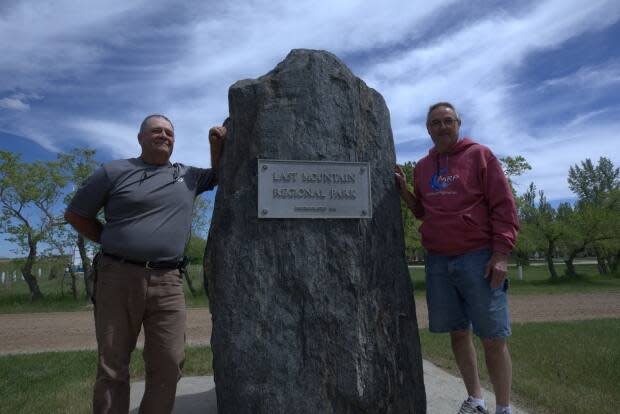
Saskatchewan is hardly known for its mountains. So why "Last Mountain?"
The park's name comes from a Cree legend describing how the Great Spirit made the nearby hills, east of Duval, from soil scooped from the valley now occupied by Last Mountain Lake.
While Last Mountain is known for its summer activities, it's extremely peaceful.
"The biggest thing for me, I think, is the quiet," said Skoropata, who has had a cottage at Last Mountain park for 26 years.
"We were living in Regina when we first started coming out here to get away from the noise. It was so nice and quiet and peaceful out here. And at night, it's so crystal clear. It's just so beautiful out here."
Manitou Regional Park
For Kathy Bergen, co-manager of Manitou and District Regional Park, the campground is an unofficial family business.
"I followed in my daughter's footsteps, because when she was in high school and university, she worked here for five years," said Bergen, who has worked at Manitou, about 100 kilometres southeast of Saskatoon, for 17 years.
"So it's been in the family for a long time and my husband does the website. So yeah, it's kind of a family business."
It's not unusual to hear that kind of story at Saskatchewan's regional parks. Many families have deep ties to the parks that marked their summers for so many years.
The Manitou Regional Park is a 10-minute walk from Little Manitou Lake, a saltwater mineral body of water that is extremely popular with Saskatchewan residents.

Bergen's co-manager is Heather Martin, who has vivid memories of the sights, sensations and smells associated with Manitou Beach, the regional park, the drive-in movie theatre and Danceland, the local dance hall. For Martin, the smell of fries and vinegar will always take her back to late nights near the beach.
"When my kids were small, which is going back probably 30 years, we would come camping here. The trees were all a fraction of the size they are now, and you could park along there and you could catch the drive-in from your seat," said Martin.
"So the kids would sit out there in the trees with their blankets and their radio … and watch the drive-in. That would probably be one of the best memories for me."
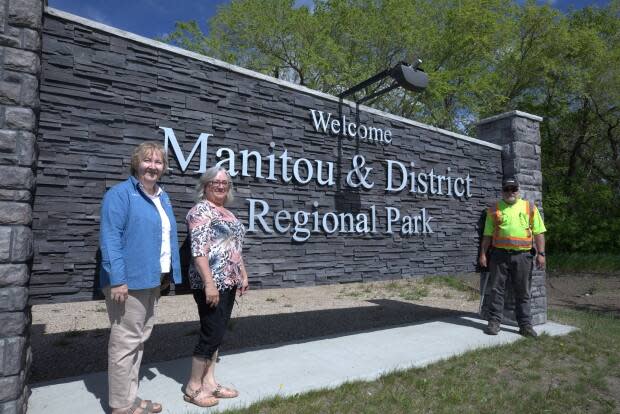
The drive-in at Manitou Beach has been around for so long, Martin remembers the first movie she saw when she herself was young: the 1973 Joe Don Baker-starring Walking Tall.
Manitou Beach is known for its mineral waters, brine shrimp and numerous local attractions. But the regional park there can be easy to miss if you're driving in the area. Its proximity to the beach is the big draw, but it also has a large children's park with a zip line, as well as a whopping 200 camp sites.
Martin said her connection to the park is not unique, as Saskatchewan residents have had a long love affair with regional parks.
"People have said how they love the regional parks in Saskatchewan because they're easier to get a reservation in than the provincial parks at times, and maybe more care is given to the upkeep," she said.
"And it's a personable experience that people have. And so yeah, regional parks are very, very well-liked in Saskatchewan overall."


